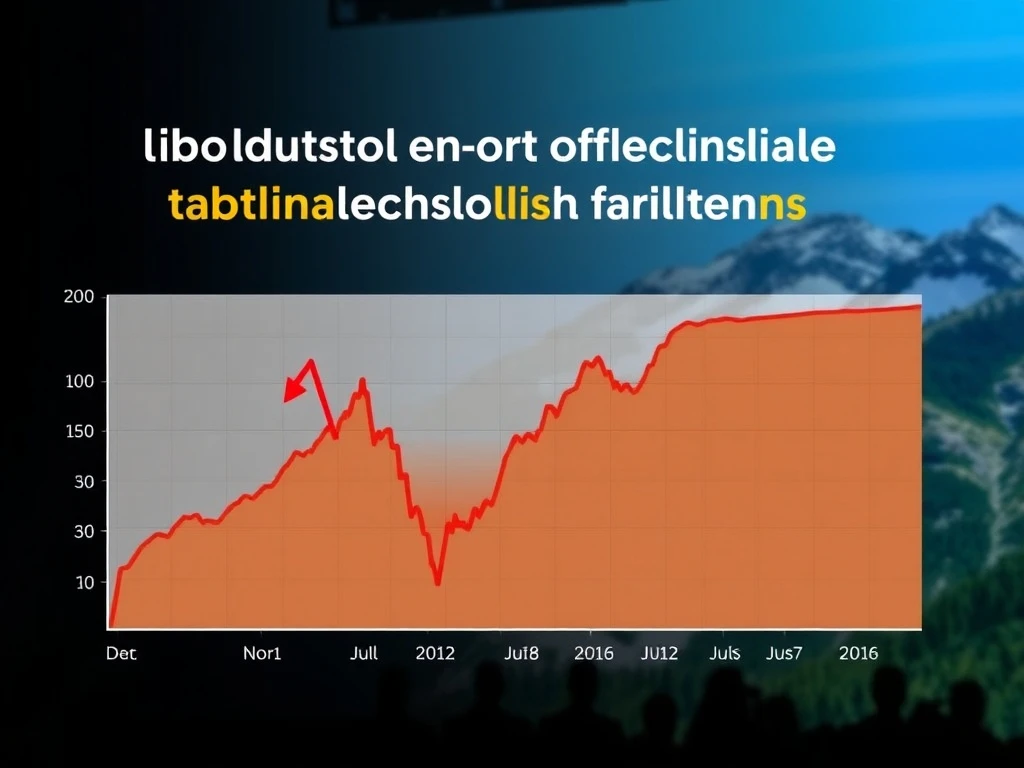The financial world holds its breath. A prominent strategist issues a stark warning. Without a crucial Jackson Hole signal, stock markets could face a severe 15% decline this autumn. This forecast highlights the immense influence of upcoming economic discussions. Investors are closely monitoring the situation. They seek clear direction.
Understanding the Critical Jackson Hole Signal
The Jackson Hole Economic Symposium is an annual gathering. Central bankers, finance ministers, and leading academics attend. Financial market participants also join. This prestigious event takes place in Jackson Hole, Wyoming. Indeed, it is highly significant. Historically, Federal Reserve chairs have used this forum. They often announce major policy shifts here. They also provide forward guidance. Therefore, any clear Jackson Hole signal becomes critical. It helps guide market expectations.
The Strategist’s Dire Outlook for Stocks
One respected market strategist projects a substantial market downturn. They indicate a potential 15% slide in stock values. This prediction hinges on the absence of a specific signal. Specifically, the market needs clarity. It requires unambiguous guidance from central banks. Without this, uncertainty could surge. Furthermore, investor confidence might erode quickly. Consequently, this could fuel the projected slide.
What kind of signal is necessary? Analysts suggest the market seeks firm assurances. These relate to inflation control. They also relate to future interest rate policies. A lack of such clarity could trigger significant volatility. Thus, investors might pull back. This withdrawal of capital could indeed fuel the projected decline.
Decoding the Crucial Jackson Hole Signal’s Components
What exactly constitutes this vital Jackson Hole signal? It primarily involves clear communication. Central bank leaders, particularly the Federal Reserve, must provide unambiguous direction. Investors are eager for details on monetary policy. They want to understand the precise path of interest rates. Moreover, they need insight into quantitative tightening or easing measures.
For instance, a strong signal might involve a clear commitment. This commitment could be to maintaining a stable economic environment. It might involve a firm stance against persistent inflation. Conversely, an ambiguous or non-committal statement could be detrimental. It leaves markets guessing. This uncertainty is precisely what the strategist warns against. Therefore, clarity is paramount for market stability.
The Potential 15% Stock Slide: A Closer Look
Should the desired Jackson Hole signal fail to materialize, the consequences for stock markets could be severe. A 15% decline represents a significant correction. Such a drop could erase months of gains. It might also trigger broader economic concerns. Consider the ripple effects. Businesses could face reduced consumer spending. Investment plans might be put on hold. Moreover, employment growth could slow. These factors combine to create a challenging environment. The market relies on predictability. Without it, volatility reigns.
Historical Influence of the Jackson Hole Signal
The Jackson Hole Symposium has a history of market-moving pronouncements. In past years, significant policy shifts have been telegraphed here. For example, Ben Bernanke used the forum to hint at quantitative easing. Similarly, Jerome Powell has used it to discuss inflation frameworks. These moments often set the tone for market performance.
Therefore, the upcoming symposium carries immense weight. Its outcomes could shape investor sentiment for months. The absence of a clear Jackson Hole signal would deviate from this historical pattern. This deviation would create unease. Indeed, markets prefer certainty.
Navigating Market Uncertainty: Key Indicators to Watch
In light of this warning, investors must remain vigilant. Pay close attention to the Federal Reserve’s statements. Analyze any nuances in central bankers’ speeches. Key areas of focus include:
- Inflation Outlook: Are central bankers confident about bringing inflation down? This is a primary concern.
- Interest Rate Trajectory: Will rates remain high? Are cuts on the horizon? These decisions directly impact borrowing costs.
- Economic Growth Projections: What is the outlook for GDP and employment? Strong growth usually supports stocks.
- Policy Tools: Any mention of new or adjusted monetary tools is important.
Understanding these elements is crucial. They will help gauge the likelihood of a supportive Jackson Hole signal.
Risk Management Strategies Amidst Jackson Hole Signal Uncertainty
Prudent risk management becomes essential. Diversify investment portfolios. Consider defensive assets. Review your personal risk tolerance. These steps can help mitigate potential losses. Do not make impulsive decisions. Instead, rely on thorough analysis.
Furthermore, stay informed. Follow economic news closely. Consult with financial advisors. They can provide tailored guidance. Preparing for various scenarios is wise. This proactive approach helps protect capital. Indeed, informed decisions are crucial.
The strategist’s warning about a potential 15% stock slide underscores the critical importance of the upcoming Jackson Hole Symposium. A clear Jackson Hole signal from central bankers is vital. It can provide the market certainty it desperately needs. Without it, the fall season could bring significant market challenges. Investors must prepare for potential volatility and monitor developments closely.
Frequently Asked Questions (FAQs)
Q1: What is the Jackson Hole Economic Symposium?
A1: The Jackson Hole Economic Symposium is an annual conference hosted by the Federal Reserve Bank of Kansas City. It brings together central bankers, finance ministers, academics, and financial market participants from around the world. They discuss current economic issues, challenges, and policy options.
Q2: Why is the “Jackson Hole signal” so important for stock markets?
A2: The “Jackson Hole signal” refers to clear indications or forward guidance provided by central bank leaders, particularly the Federal Reserve Chair, regarding future monetary policy. Historically, significant policy shifts or intentions have been telegraphed at this symposium. Markets react strongly to these signals, as they impact interest rates, inflation expectations, and economic growth prospects, all of which influence stock valuations.
Q3: Which strategist made this specific prediction about a 15% stock slide?
A3: The article refers to “one strategist” without naming a specific individual or firm. This is common in financial reporting when a view is gaining traction among a segment of analysts but might not be universally endorsed or attributed to a single, named source to avoid speculation or misattribution. The focus remains on the nature of the warning and its implications.
Q4: What should investors do if the Jackson Hole signal is not clear?
A4: If the Jackson Hole signal is ambiguous, investors should prioritize risk management. This includes diversifying portfolios, considering defensive assets (like bonds or certain commodities), reviewing personal risk tolerance, and avoiding impulsive decisions. Staying informed about economic news and consulting with a financial advisor are also crucial steps to navigate potential market volatility.
Q5: Has Jackson Hole always influenced markets this much?
A5: The Jackson Hole Symposium has consistently been a significant event for market watchers, especially since the early 2000s. Its influence grew as central banks became more proactive in guiding expectations. Major announcements by Fed chairs like Ben Bernanke and Jerome Powell have often set the tone for monetary policy and market direction for months afterward, solidifying its reputation as a key event on the economic calendar.
Q6: What kind of economic data influences the Jackson Hole signal?
A6: The signal from Jackson Hole is heavily influenced by current and projected economic data. Key indicators include inflation rates (CPI, PCE), employment figures (non-farm payrolls, unemployment rate), GDP growth, consumer spending, and manufacturing data. Central bankers analyze these figures to determine the appropriate monetary policy stance, which then informs their statements at the symposium.














